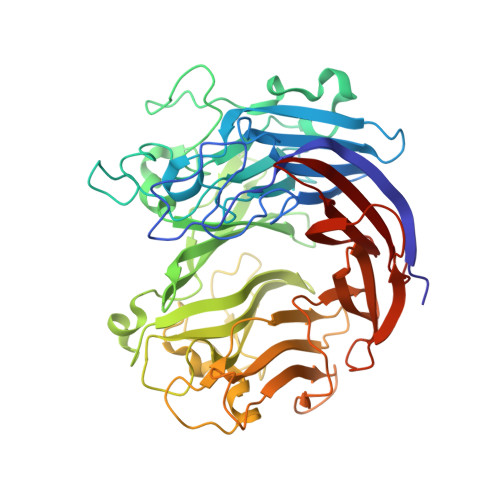Biochemical characterization and structural analysis of ulvan lyase from marine Alteromonas sp. reveals the basis for its salt tolerance.
Qin, H.M., Gao, D., Zhu, M., Li, C., Zhu, Z., Wang, H., Liu, W., Tanokura, M., Lu, F.(2020) Int J Biol Macromol 147: 1309-1317
- PubMed: 31751708
- DOI: https://doi.org/10.1016/j.ijbiomac.2019.10.095
- Primary Citation of Related Structures:
6JQ9 - PubMed Abstract:
Marine macroalgae have gained considerable attention as renewable biomass sources. Ulvan is a water-soluble anionic polysaccharide, and its depolymerization into fermentable monosaccharides has great potential for the production of bioethanol or high-value food additives. Ulvan lyase from Alteromonas sp. (AsPL) utilizes a β-elimination mechanism to cleave the glycosidic bond between rhamnose 3-sulfate and glucuronic acid, forming an unsaturated uronic acid at the non-reducing end. AsPL was active in the temperature range of 30-50 °C and pH values ranging from 7.5 to 9.5. Furthermore, AsPL was found to be halophilic, showing high activity and stability in the presence of up to 2.5 M NaCl. The apparent K m and k cat values of AsPL are 3.19 ± 0.37 mg mL -1 and 4.19 ± 0.21 s -1 , respectively. Crystal structure analysis revealed that AsPL adopts a β-propeller fold with four anti-parallel β-strands in each of the seven propeller blades. The acid residues at the protein surface and two Ca 2+ coordination sites contribute to its salt tolerance. The research on ulvan lyase has potential commercial value in the utilization of algal resources for biofuel production to relieve the environmental burden of petrochemicals.
Organizational Affiliation:
Key Laboratory of Industrial Fermentation Microbiology of the Ministry of Education, Tianjin Key Laboratory of Industrial Microbiology, College of Biotechnology, Tianjin University of Science and Technology, National Engineering Laboratory for Industrial Enzymes, Tianjin 300457, PR China.
















